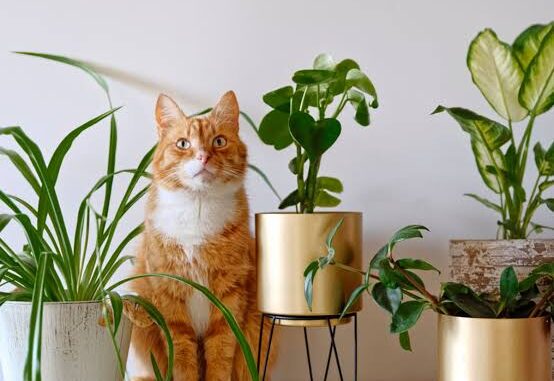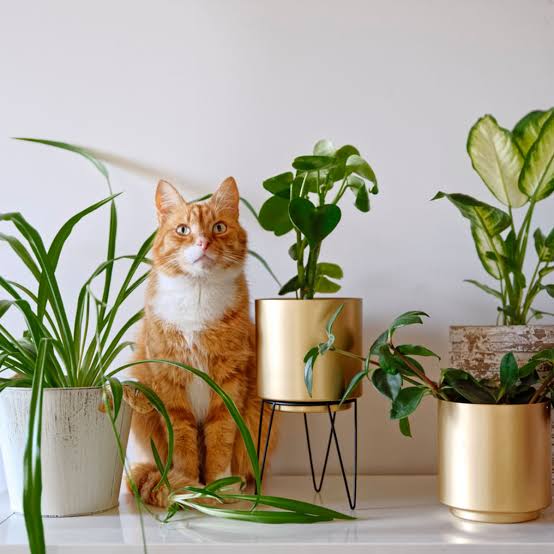
The Best Indoor Plants That Are Safe for Cats: Adding indoor plants to your home brings life, beauty, and cleaner air. But if you’re a cat owner, choosing the right houseplants is more than an aesthetic decision—it’s a matter of safety. Many common plants, such as lilies, philodendrons, and pothos, are toxic to cats and can cause symptoms ranging from mild irritation to serious illness or even death.

Fortunately, there are many beautiful, cat-safe plants you can grow indoors. Whether you’re a seasoned plant parent or just starting out, here’s a comprehensive guide to the best indoor plants that are non-toxic to cats, along with tips on plant care, placement, and feline safety.
Why Plant Safety Matters for Cat Owners
Cats are naturally curious and often explore their environment with their mouths. They chew on leaves, dig in soil, and knock over pots often for fun or attention. Some plants can cause mild symptoms like drooling or vomiting, but others can lead to serious reactions such as kidney failure or neurological issues.
The ASPCA (American Society for the Prevention of Cruelty to Animals) maintains a comprehensive database of toxic and non-toxic plants. It’s essential to cross-reference any new plant before bringing it home.
Top Cat-Safe Indoor Plants
1. Spider Plant (Chlorophytum comosum)
- Light: Bright, indirect light
- Water: Keep soil moist but not soggy
- Why it’s safe: Non-toxic and playful cats love the arching leaves
- Bonus: Excellent air purifier
Spider plants are hardy, fast-growing, and tolerant of varying conditions. They’re also visually appealing with their fountain-like arch and variegated leaves.
2. Areca Palm (Dypsis lutescens)
- Light: Bright, filtered light
- Water: Let soil dry slightly between waterings
- Why it’s safe: No known toxic effects on cats
- Bonus: Adds a tropical feel to your home
Unlike some other palms, the Areca is safe for felines and thrives indoors when kept in bright areas.
3. Bamboo Palm (Chamaedorea seifrizii)
- Light: Moderate to bright indirect light
- Water: Regular, allowing topsoil to dry
- Why it’s safe: Non-toxic to cats
- Bonus: Helps remove air pollutants
Also called the reed palm, this elegant, tall plant adds vertical interest to rooms without endangering your pets.
4. Calathea (Various species)
- Light: Low to medium, indirect light
- Water: Consistently moist soil; avoid overwatering
- Why it’s safe: Cat-safe and visually striking
- Bonus: Unique leaf movements (prayer plants)
Calatheas are known for their vibrant, patterned foliage. Though finicky, they’re safe for your curious cat.
5. Peperomia (Various species)
- Light: Bright, indirect light
- Water: Let the soil dry out between watering
- Why it’s safe: Non-toxic to cats
- Bonus: Compact and low-maintenance
Peperomias come in many shapes, textures, and colors, making them a great fit for small spaces or desks.
6. Parlor Palm (Chamaedorea elegans)
- Light: Low to moderate light
- Water: Water when topsoil is dry
- Why it’s safe: Completely non-toxic to cats
- Bonus: Easy to care for and beginner-friendly
The parlor palm brings classic elegance to any room and can survive in less-than-ideal lighting conditions.
7. Boston Fern (Nephrolepis exaltata)
- Light: Bright, indirect light
- Water: Keep consistently moist
- Why it’s safe: Non-toxic, though tempting to chew
- Bonus: Great for hanging baskets
Boston ferns love humidity and are ideal for bathrooms or kitchens. Cats may enjoy batting at the fronds, so hang them up if needed.
8. Prayer Plant (Maranta leuconeura)
- Light: Low to medium, indirect light
- Water: Keep soil moist, not soggy
- Why it’s safe: Safe for cats
- Bonus: Beautiful leaf movement at night
The prayer plant gets its name from its leaves’ habit of folding up at night, resembling praying hands.
9. African Violet (Saintpaulia)
- Light: Bright, indirect light
- Water: Water from the bottom to avoid leaf spots
- Why it’s safe: Non-toxic to cats
- Bonus: Blooms year-round with proper care
These compact, flowering plants are colorful and cat-safe, perfect for windowsills and small tables.
10. Baby Rubber Plant (Peperomia obtusifolia)
- Light: Bright to moderate indirect light
- Water: Allow the top inch of soil to dry
- Why it’s safe: Non-toxic and durable
- Bonus: Glossy, succulent-like leaves
Not to be confused with the toxic rubber tree (Ficus elastica), this peperomia variety is harmless to felines.
READ ALSO: The Best Pet Cameras to Monitor Your Cat
Tips for Keeping Plants and Cats Peacefully Coexisting
Even with cat-safe plants, you may still need to set boundaries. Here are some tips to help both your plants and pets thrive:
1. Elevate or Hang Plants
Use wall shelves, plant stands, or hanging baskets to keep plants out of your cat’s direct reach—especially if they like to dig or chew.
2. Use Decorative Covers or Rocks
Place decorative stones or a mesh layer on top of the soil to discourage digging.
3. Provide Cat Grass or Catnip
Offer designated pet-safe plants for chewing, such as:
- Cat Grass (wheatgrass)
- Catnip (Nepeta cataria)
This can reduce their interest in your decorative houseplants.
4. Avoid Fertilizer Overuse
While the plant may be safe, fertilizers or soil additives can cause irritation if ingested. Stick to pet-safe fertilizers and rinse off excess residue.
5. Discourage Plant Play
Use safe deterrents:
- Citrus scents (lemon/orange peels near pots)
- Aluminum foil or double-sided tape around plant bases
Avoid spraying your cat or yelling—it’s ineffective and may damage trust.
Plants to Absolutely Avoid (Toxic to Cats)
To be thorough, here are some popular houseplants that should never be kept around cats:
- Lilies (all varieties) – Highly toxic; can cause kidney failure
- Sago Palm – Extremely poisonous
- Aloe Vera – Common but toxic
- Peace Lily – Causes drooling, vomiting, and oral irritation
- Philodendron & Pothos – Contains insoluble calcium oxalates
- Snake Plant (Sansevieria) – Mildly toxic
- Dieffenbachia (Dumb Cane) – Irritating to mouth and digestive tract
Always double-check plant safety before buying, especially from generic nurseries or supermarkets.
FAQs
How do I know if a plant is toxic to my cat?
Check trusted databases like the ASPCA’s plant toxicity list or consult your vet. Avoid relying solely on plant labels at garden stores—they often don’t indicate toxicity.
What happens if my cat eats a non-toxic plant?
Even safe plants can cause mild issues like upset stomachs or vomiting if consumed in large amounts. Monitor your cat and remove the plant if they’re overly interested in it.
Why is my cat obsessed with chewing plants?
This could be due to:
- Curiosity
- Boredom
- Nutritional deficiency (e.g., fiber)
- Teething (in kittens)
Offer cat grass or enrich their environment to redirect the behavior.
Can I keep toxic plants if my cat never bothers them?
It’s risky. Cats are unpredictable, and one nibble could be dangerous—especially with highly toxic plants like lilies. Better to be safe and swap for a non-toxic alternative.
Are succulents safe for cats?
Some are, but many (like jade plants and aloe) are toxic. Safe options include:
- Haworthia
- Echeveria
- Burro’s Tail (Sedum morganianum)
Always check the species first.
Is it safe to use plant pest sprays around cats?
Many chemical sprays can be harmful. Use pet-safe pesticides, neem oil, or insecticidal soaps. Always allow treated plants to dry fully before reintroducing your cat to the area.
My cat knocks over all my pots. What can I do?
Try:
- Heavier pots or weighted bases
- Using sticky tape or citrus deterrents around pots
- Redirecting energy with toys or interactive play
Some cats also dislike cacti or spiky-leafed plants, which can act as a natural deterrent (but only if those plants are also safe).
Leave a Reply
You must be logged in to post a comment.